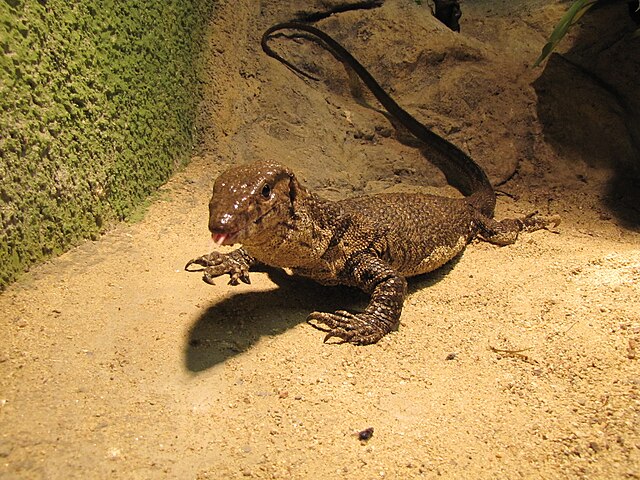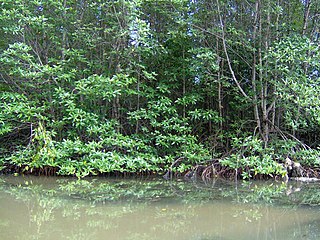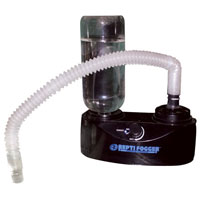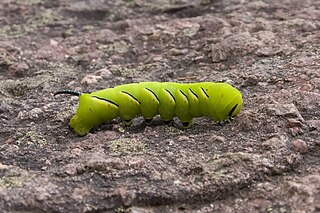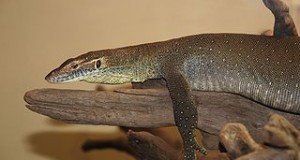The Dumeril’s or Brown Rough-Necked Monitor (Varanus dumerilii) is still collected from the wild, but captive breeding is increasing, and will, I hope, soon be the rule rather than the exception. Although the black and orange hatchlings are hard to resist, Dumeril ownership should not be entered into lightly. Strong and active, adults may top 4.5 feet in length, and are best reserved for those with adequate space and experience. That being said, Dumeril’s Monitors are reputed to be somewhat easier to handle than other similarly sized species. My own experience bears this out, but individual personalities vary greatly…caution and respect for their powerful jaws and sharp claws is a must. For those up to it, this is definitely a species worth considering, as it is little studied in the wild and unprotected across much of its range (and a very interesting creature as well!).
Description
The Dumeril’s Monitor sports a “typical” monitor build and averages 3-4 feet in length, with some individuals approaching 5 feet. Hatchlings and very young individuals are brilliantly clad in black and orange. Adults are attractively-marked in various shades of brown and tan. Extremely sharp claws (even by monitor standards!) assist it in climbing.
Range
The Dumeril’s Monitor is found across a huge range that extends from southern Myanmar and Thailand through western Malaysia and much of Indonesia to Singapore. The population on Singapore was long believed extinct, with no reported sightings since 1935. However, a single individual was collected in the island’s Nee Soon Swamp Forest in 2008, spurring hopes that it is still hanging on there.
Habitat
The Dumeril’s Monitor inhabits lowland forests, coastal mangrove swamps and swamp forests. Village and farm outskirts are sometimes colonized, but the effects of habitat development on this species have not been studied. It is at times highly arboreal, but also frequently forages on the ground and in the shallows of rivers and swamps.
Enclosure
Like most of their relatives, Dumeril’s Monitors are quite active, and will not thrive in close quarters. Adults require custom-built cages measuring at least 6 x 4 x 6 feet.
Cypress mulch or eucalyptus bark may be used as a substrate. Shy by nature, they are best provided with numerous caves, cork bark rolls and hollow logs in which to shelter, and stout climbing branches for climbing. Some individuals prefer sheltering above ground (wild individuals reportedly utilize tree hollows), so a cork bark roll or large nest box positioned among the branches would be ideal. A water bowl large enough for soaking should always be available…the ideal Dumeril’s enclosure would feature a large, drainable pool.
The cage should be located in a quiet, undisturbed area of the home, as Dumeril’s Monitors are very aware of their surroundings, and easily stressed.
Temperature
Dumeril’s Monitors fare best when afforded a temperature gradient of 78-85 F; nighttime temperatures should not dip below 75 F. The basking site should be kept at 110-120 F. Incandescent bulbs may be used by day; ceramic heaters or red/black reptile “night bulbs” are useful after dark.
Provide your monitor with the largest home possible, so that a thermal gradient (areas of different temperatures) can be established. Thermal gradients, critical to good health, allow reptiles to regulate their body temperature by moving between hot and cooler areas. In small or poorly ventilated enclosures, the entire area soon takes on the basking site temperature.
Humidity should average 70-85%, but dry areas must be available. A commercial reptile mister will be helpful if your home is especially dry.
Light
While there is some evidence that UVB exposure may not be essential if the animal is fed properly, I always provide it to monitors in zoo exhibits and at home. In most situations, UVB exposure is the safest option. If a florescent bulb is used (Zoo Med bulbs are ideal), be sure that your pet can bask within 6-12 inches of it. Mercury vapor bulbs broadcast UVB over greater distances, and provide beneficial UVA radiation as well.

Uploaded to Wikipedia Commons by Melongal
Diet
The few available studies indicate that wild Dumeril’s Monitors take a wide variety of prey animals, including grasshoppers, roaches, and other large insects, frogs, crabs, snails, bats, rodents and other small mammals, birds and their eggs, turtle eggs, and fish. Populations living in mangrove swamps seem to favor crabs and snails…in my experience, crabs and crayfish always elicit a vigorous feeding response from captives.
I do not use a rodent-only diet for these or other monitors from similar habitats (i.e. the Black Rough-Necked Monitor). Youngsters should be fed largely upon roaches, super mealworms, earthworms, snails, hornworms and other invertebrates, along with small whole fishes, un-shelled shrimp, fiddler and green crabs, crayfish and squid. Pinkies or small mice may be provided once weekly, and hard-boiled eggs can be used on occasion. All meals (other than fishes, crabs and rodents) offered to growing monitors should be powdered with calcium, and a high-quality reptile vitamin/mineral supplement should be used 3x weekly. I favor ReptiVite and ReptiCalcium.
Rodents and whole fish can comprise 50% of the adult diet, with a variety of large insects, earthworms, hard-boiled eggs, crayfish, crabs, shrimp, snails, and similar foods making up the balance. Calcium and vitamin/mineral supplements should be used 1-2x weekly. Large food items should be avoided; even where adult monitors are concerned, mice are preferable to small rats.
Temperament
Although not a species for beginners, Dumeril’s Monitors adjust well to captivity when given proper care, and make fine, long-lived pets. Initially shy, some learn to trust gentle caretakers, while others – especially wild-caught individuals – remain wary. A large, well-furnished cage will provide the security that is essential if they are to become approachable.
In common with all monitors, they are capable of inflicting serious injuries with their powerful jaws, long tails and sharp claws. Thick leather gloves should be worn when handling Dumeril’s Monitors, as even tame individuals leave deep scratches with their claws in the course of their normal movements.
Breeding
A single male can be housed with 1 or 2 females, but they must be watched carefully. The nesting area should be enclosed (i.e. a large tub or plastic storage container within a wooden box equipped with an entrance hole) and stocked with 2-3 feet of a slightly moist mix of sand, top soil and peat moss.
We have a good deal to learn about captive reproduction. Success (and failure) has been reported under a wide variety of conditions. Please post below for detailed information on pairing adults and incubating the eggs.
Further Reading
Monitor Ownership: Important Considerations
 That Reptile Blog – Reptile, Amphibian and Exotic Pet Care and Information
That Reptile Blog – Reptile, Amphibian and Exotic Pet Care and Information

